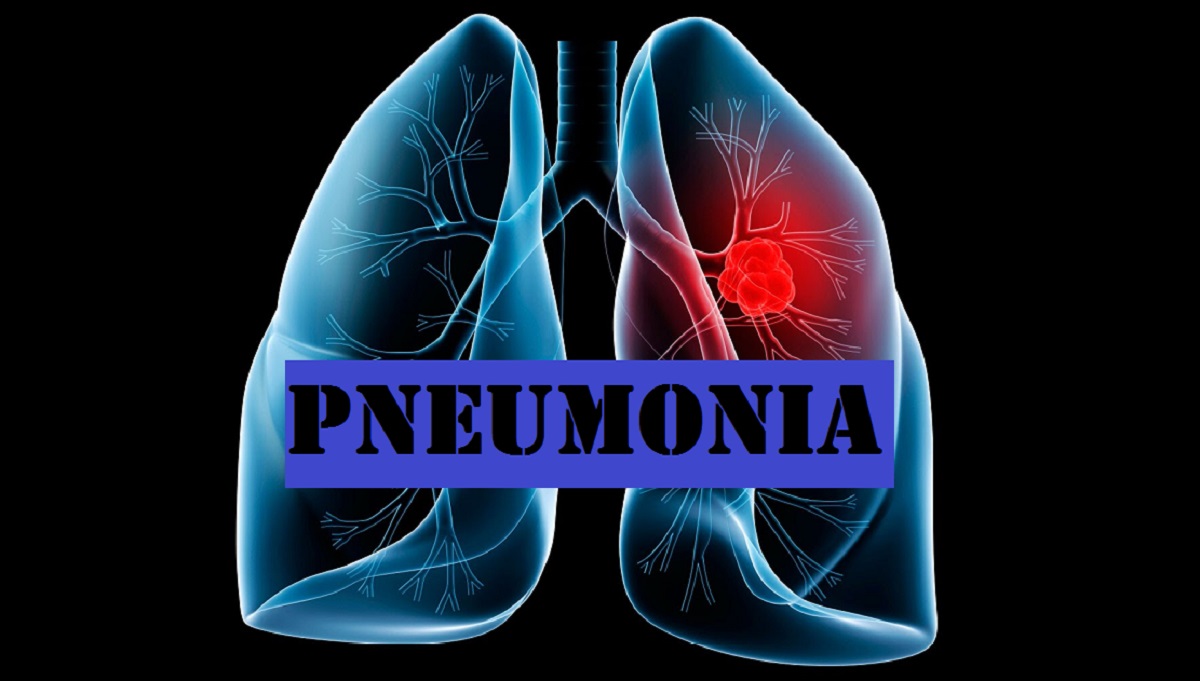Pneumonia
Pneumonia is an infection that inflames the air sacs in one or both lungs. The air sacs may fill with fluid or pus (purulent material), causing cough with phlegm or pus, fever, chills, and difficulty breathing. A variety of organisms, including bacteria, viruses and fungi, can cause pneumonia.
Pneumonia can range in seriousness from mild to life-threatening. It is most serious for infants and young children, people older than age 65, and people with health problems or weakened immune systems.
Symptoms
The first symptoms of pneumonia usually resemble those of a cold or flu. The person then develops a high fever, chills, and cough with sputum.
Common symptoms include:
cough
rusty or green phlegm, or sputum, coughed up from lungs
fever
fast breathing and shortness of breath
shaking chills
chest pain that usually worsens when taking a deep breath, known as pleuritic pain
fast heartbeat
fatigue and weakness
nausea and vomiting
diarrhea
sweating
headache
muscle pain
confusion or delirium, especially in older adults
dusky or purplish skin color, or cyanosis, from poorly oxygenated blood
Symptoms can vary depending on other underlying conditions and the type of pneumonia.
Diagnosis
A doctor will ask about symptoms and medical history and will carry out a physical examination.
They may suspect pneumonia if they hear coarse breathing, wheezing, crackling, or decreased breath sounds when listening to the chest through a stethoscope.
The doctor may also check the oxygen levels in the blood with a painless monitor on the finger called a pulse oximeter
Chest X-rays can confirm a pneumonia diagnosis and show which areas of the lungs are affected.
A CT scan of the chest may provide more detailed information.
Blood tests measure the white blood cell count.
This helps determine how severe the infection is, and whether a bacteria, virus, or fungus is the likely cause.
Blood cultures may reveal whether the microorganism from the lungs has spread into the blood stream.
An arterial blood gas (ABG) blood test may provide a more accurate reading of the body's oxygen and carbon dioxide levels and other factors.
A sputum analysis can determine which organism is causing the pneumonia.
A bronchoscopy is sometimes used for further investigation.
A thin, flexible, and lighted tube called a bronchoscope is passed down into the lungs. This enables the doctor to examine directly the infected parts of the airways and lungs. The patient is under anesthetic.
Types
There are different types of pneumonia, depending on their cause.
Bacterial pneumonia: The most common cause is the bacterium Streptococcus pneumoniae (S. pneumoniae), but many different bacteria can cause pneumonia
Viral pneumonia: This can result from the respiratory syncytial virus (RSV) and influenza types A and B, known as the flu
Aspiration pneumonia: This can happen when a person breathes food, liquids, or stomach contents into the lungs. This type is not contagious.
Fungal pneumonia: This can result from a condition such as valley fever, caused by the Coccidioides fungus.
Hospital-acquired pneumonia: This can occur in patients being treated for other conditions, for example, those attached to a respirator, or breathing machine.
Causes
Many germs can cause pneumonia. The most common are bacteria and viruses in the air we breathe. Your body usually prevents these germs from infecting your lungs. But sometimes these germs can overpower your immune system, even if your health is generally good.
Pneumonia is classified according to the types of germs that cause it and where you got the infection.
Community-acquired pneumonia
Community-acquired pneumonia is the most common type of pneumonia. It occurs outside of hospitals or other health care facilities. It may be caused by:
Bacteria. The most common cause of bacterial pneumonia in the U.S. is Streptococcus pneumoniae. This type of pneumonia can occur on its own or after you've had a cold or the flu. It may affect one part (lobe) of the lung, a condition called lobar pneumonia.
Bacteria-like organisms. Mycoplasma pneumoniae also can cause pneumonia. It typically produces milder symptoms than do other types of pneumonia. Walking pneumonia is an informal name given to this type of pneumonia, which typically isn't severe enough to require bed rest.
Fungi. This type of pneumonia is most common in people with chronic health problems or weakened immune systems, and in people who have inhaled large doses of the organisms. The fungi that cause it can be found in soil or bird droppings and vary depending upon geographic location.
Viruses. Some of the viruses that cause colds and the flu can cause pneumonia. Viruses are the most common cause of pneumonia in children younger than 5 years. Viral pneumonia is usually mild. But in some cases it can become very serious.
Prevention
Get vaccinated. Vaccines are available to prevent some types of pneumonia and the flu. Talk with your doctor about getting these shots. The vaccination guidelines have changed over time so make sure to review your vaccination status with your doctor even if you recall previously receiving a pneumonia vaccine.
Make sure children get vaccinated. Doctors recommend a different pneumonia vaccine for children younger than age 2 and for children ages 2 to 5 years who are at particular risk of pneumococcal disease. Children who attend a group child care center should also get the vaccine. Doctors also recommend flu shots for children older than 6 months.
Practice good hygiene. To protect yourself against respiratory infections that sometimes lead to pneumonia, wash your hands regularly or use an alcohol-based hand sanitizer.
Don't smoke. Smoking damages your lungs' natural defenses against respiratory infections.
Keep your immune system strong. Get enough sleep, exercise regularly and eat a healthy diet.
Treatment
Treatment depends on the type and severity of the pneumonia.
Bacterial types of pneumonia are usually treated with antibiotics.
Viral types of pneumonia are usually treated with rest and plenty of fluids. Antiviral medications can be used in influenza.
Fungal types of pneumonia are usually treated with antifungal medications.
Doctors commonly prescribe over-the-counter (OTC) medications to help manage the symptoms of pneumonia. These include treatments for reducing fever, reducing aches and pains, and suppressing coughs.
In addition, it is crucial to rest and drink plenty of fluids. Staying hydrated helps to thin out thick phlegm and mucus, making it easier to cough up.
Hospitalization for pneumonia may be required if symptoms are especially bad or if an individual has a weakened immune system or other serious illnesses.
In the hospital, patients are generally treated with intravenous antibiotics and fluids. They may need a supplemental oxygen supply.
Zinc deficiency is one epidemic that people are mostly unaware of. As per the data shared by World Health Organization, around 31% of the world population is suffering from zinc deficiency. The problem is also ranked 5th in the leading factors that cause several diseases. It is also a primary reason why underdeveloped nations suffer from high mortality rate as zinc deficiency is associated with child pneumonia and diarrhea.
Every person, young or old, needs to have a regular intake of zinc for a healthy life, which it is known as an essential nutrient. It is also present in every cell, tissue, bone and fluid in the human body; zinc is especially prevalent in male semen and prostate glands.
Common Symptoms Of Zinc Deficiency
Unfortunately, millions of people suffering from zinc deficiency are unaware of their condition. However, looking out for certain key indicators can help in identifying the problem before it becomes severe. Here are the common symptoms of zinc deficiency that everyone must look out for:
Diarrhea & Leaky Gut- Impaired immunity causes zinc deficiency diarrhea, which can become a persistent health problem. Every year diarrhea affects nearly 2 million children worldwide, and most of them are suspected to have a zinc deficiency and bacterial infection. Leaky gut, also called intestinal permeability can lead to a slew of health problems like skin allergies, thyroid problems, and nutrient malabsorption.
Zinc Rich Foods You Must Include In Your Diet
If you are experiencing any of the symptoms shared above, then you might be suffering from the zinc deficiency. To improve the level of zinc in your body, you can either take all natural zinc supplements. But, supplements usually contain several forms of zinc like zinc sulfate, zinc acetate and more. Thus, it is better to include the below-shared foods in your diet, which contain a high amount of zinc:
Pumpkin seeds –1/2 cup: 8.4 mg
Lamb– 4 oz: 5.2 mg
Cashews –1/2 cup: 3.8 mg
Chickpeas (Garbanzo beans) –1 cup cooked: 2.5 mg
Mushrooms –1 cup cooked: 1.9 mg
Chicken – 4 oz: 1.6 mg
Kefir or Yogurt – 1 cup: 1.4 mg
Spinach –1 cup cooked: 1.4 mg
Cocoa powder – 1 Tbsp: 0.4 mg
While bad cholesterol has been blamed for increasing risk of heart disease, variations in the good cholesterol levels may also lead to infectious diseases such as gastroenteritis or pneumonia, according to a study.
Individuals with very low high-density lipoproteins (HDL) cholesterol had a 75 per cent higher risk of infectious disease, whereas the risk was 43 per cent higher in those with very high HDL cholesterol, the researchers said.
“We found that individuals with both low and high HDL cholesterol had high risk of hospitalisation with an infectious disease,” said Borge Nordestgaard, Professor at the University of Copenhagen in Demark.
“Importantly, these groups of individuals also had high risk of dying from infectious disease,” Nordestgaard added.
For the findings, published in the European Heart Journal, the team examined the data from 100,000 individuals.
“Numerous studies in animals and cells indicate that HDL is of importance for the function of the immune system and thereby the susceptibility to infectious disease. However, this study is the first to examine if HDL is associated with the risk of infectious disease among individuals from the general population,” explained co-author Christian Medom Madsen, post-doctoral student at the varsity.
However, the study cannot conclude that very low or very high HDL is the direct cause of the increased risk of infectious disease.
“Our findings indicate that, in the future, research into the role and function of HDL should not narrowly focus on cardiovascular disease, but rather focus on the role of HDL in other disease areas, such as infectious disease,” Nordestgaard said.
न्युमोनिया
'न्युमोनिया' हा फुफ्फुसांचा सांसर्गिक आहे. ह्यामध्ये फुफ्फुसांच्या आतील अल्वोली - म्हणजे श्वसनसंस्थेच्या अगदी बारीक नलिका ज्या फुफ्फुसांमध्ये वायूच्या हस्तांतरणाचे काम करतात त्या न्युमोनियाकोकस जीवाणूच्या संसर्गास बळी पडतात आणि परिणामी फुफ्फुसांमध्ये द्रव साठू लागतो. ह्या द्रवामुळे फुफ्फुसांची कार्यक्षमता कमी होते व त्यात कफसारखा द्रव जमुन रहातो. न्युमोनियामध्ये एक किंवा दोन्ही फुफ्फुसांना संसर्ग होऊ शकतो.
न्यूमोनिया हे लक्षण आहे. नेमक्या आजाराचे नाव नाही. पण डॉक्टर न्यूमोनिया फारसा काळजी करण्यासारखा आजार असल्याचे सांगतात. या आजारात प्रचलित असलेली आणखी एक वैद्यकीय शब्द म्ह्णजे डबल न्यूमोनिया- म्ह्णजे दोन्ही फुफ्फुसामध्ये संसर्ग पोहोचल्याचे लक्षण. दोन्ही फुफ्फुसामध्ये संसर्ग होणे ही सामान्य बाब आहे. न्यूमोनियामध्ये फुफ्फुसामध्ये जिवाणू, विषाणू किंवा कवकांचा संसर्ग होतो. फुफ्फुसाच्या वायुकलिकामध्ये द्रव किंवा पू साठतो. यामुळे वायुकलिकामधून पुरेसा ऑक्सिजन शरीरास मिळत नाही. ऑक्सिजनच्या कमतरतेमुळे पेशींचे कार्य नीट्से होत नाही. योग्य उपचार केले नाहीत तर ऑक्सिजनच्या कमतरतेमुळे व्यक्तीचा मृत्यू ओढवतो. न्यूमोनियाचे तीन प्रकार आहेत जिवाणूजन्य, विषाणूजन्य आणि मायकोप्लाझमा (कवक). न्यूमोसिस्टिस कॅरिनी नावाच्या कवकामुळे झालेला न्यूमोनिया विरळा आहे . या प्रकारचा न्यूमोनिया सहसा एड्स रुग्णाना होतो. क्षयाचे पर्यवसान कधी कधी न्यूमोनियामध्ये होते. निरोगी व्यक्तीचा मृत्यू न्यूमोनियाने सहसा होत नाही. पण न्यूमोनियाने फुफ्फुसात घर केले म्ह्णजे एड्स झालेल्या रुग्णाच्या जीवितास धोका उद्भवतो. सध्या उत्तम उपचार उपलब्ध असल्याने न्यूमोनियाने मरण पावणा-या व्यक्तींची संख्या कमी झाली आहे. तरी पण जगभराच्या म्रृत्यूचे न्यूमोनिया हे सातवे कारण आहे.
न्यूमोनियाची लक्षणे
- ताप
- थंडी वाजणे
- खोकला
- श्वास जलद होणे (गति वाढणे )
- श्वास घेताना धाप लागणे
- छातीत आणि पोटात दुखणे
- शक्तिपात
- उलट्या
जिवाणूजन्य न्यूमोनिया हळुवारपणे किंवा एकाएकी उत्पन्न होतो.
गंभीर न्यूमोनिया रुग्णामधील लक्षणे
- हुडहुडी भरणे.
- तीव्र ताप
- छातीत दुखणे
- अपुरा श्वास
- खोकल्यातून हिरवा, पिवळा किंवा तपकिरी कफ
विषाणूजन्य न्यूमोनियाची प्रारंभीच्या काळातील लक्षणे फ्लूसारखी असतात. ताप, कोरडा खोकला, डोकेदुखी, अंग दुखी आणि अशकतपणा .याशिवाय 12-36 तासात रुग्णास अधिकाधिक श्रेणीमध्ये श्वास लागतो. श्वसन अपुरे होते, कफ़ तीव्र होतो, थोडा कफ पडतो. ताप वाढतो.श्वास घेणे कठीण होते. आणि ओठ निळे पडतात. टोकाच्या गुंतागुंतीमध्ये जिवाणू संसर्ग होतो.
मायकोप्लाझमा न्यूमोनियाची लक्षणे
मायकोप्लाझमा न्यूमोनियाची लक्षणे भिन्न आहेत. याला चालता फिरता (वॉकिंग) न्यूमोनिया म्हणतात. याची लक्षणे विविध आहेत. एकसारखी लक्षणे नसणे हेच याचे वैशिष्ठ्य.घसा खवखवण्यापासून झालेल्या लक्षणांचा प्रारंभ दीर्घकाळ चाललेल्या खोकल्यामध्ये होतो. दम्याच्या रुग्णामध्ये मायकोप्लाझमा न्यूमोनिया तीव्र आणि दीर्घकालीन स्वरूप घेतो.
लक्षणे-
- अधून मधून खोकल्याची मोठी उबळ . पांढ-या रंगाचा कफ. कफ़ाचे प्रमाण कमी असते.
- हुडहुडी भरून थंडी वाजणे हे आजाराचे प्रारंभीचे लक्षण आहे.
- मळमळ किंवा उलट्या
शरीराची प्रतिकारशक्ती कमी झाल्यास किंवा तिचे संतुलन बिघडल्यास न्युमोनिया होण्याची शक्यता जास्त असते. श्वसनमार्गाच्या वरील बाजूस प्रथम संसर्ग होतो किंवा तो सिस्टेमिक म्हणजे सर्वसाधारण स्वरूपाचाही असू शकतो. तोंड, घसा किंवा नाकात असलेले जीवाणू अथवा विषाणू फुफ्फुसामध्ये शिरल्यास हा रोग होतो.
न्युमोनिया हा बालकांचा अदृश्य मारेकरी आहे. मलेरिया, गोवर किंवा एड्सने मरणाऱ्या मुलांपेक्षा न्युमोनियामुळे मरणाऱ्या मुलांची संख्या जास्त आहे. गेल्या काही वर्षांमध्ये न्युमोनियाकोकस या जीवाणूने औषधांना विरोध करायला सुरुवात केली आहे आणि हीच सर्वांत गंभीर बाब आहे.
उपचार
डॉक्टरांच्या सल्ल्याने योग्य ते प्रतिजैविक हा योग्य उपचार आहे.
'न्यूमोनिया' हा शब्दच भीतीदायक आहे. त्यातही लहान बाळांना न्यूमोनिया झाला की, त्यांचे आई-बाबा एकदम घाबरून जातात. न्यूमोनिया प्रसंगी चिंताजनक ठरतो हे खरं असलं तरी त्याला प्रतिबंध करणं शक्य आहे आणि उपचारही शक्य आहेत. योग्य काळजी आणि वेळीच सुरू केलेले उपचार हाच न्यूमोनियावरील उपाय असून त्यामुळे या आजारासंबंधी आपल्या मनात असलेली भीती आधी दूर करायला हवी. न्यूमोनिया म्हणजे फुफ्फुसांमध्ये झालेला संसर्ग. हा संसर्ग विषाणूजन्य, जीवाणूजन्य किंवा बुरशीजन्य (फंगल) असू शकतो. यातील विषाणूजन्य न्यूमोनिया अधिक प्रमाणात आढळतो. आपल्या फुफ्फुसात हवेच्या लहान-लहान पिशव्या असतात. न्यूमोनियामध्ये या पिशव्यांमध्ये संसर्ग होऊन सूज येते आणि त्यात 'कफ' जमतो. श्वास घेण्यास त्रास होणं, खोकताना किंवा श्वास घेताना छातीत दुखणं ही न्यूमोनियाची सामान्य लक्षणं आहेत.
पाच वर्षांच्या आतील बालकांमध्ये न्यूमोनियापासून संरक्षण मिळवण्यासाठी लसीकरण हा सर्वांत चांगला उपाय आहे. 'न्यूमोकोक्कल' लस तसंच 'एचआयबी' लस (हिमोफिलिस इन्फ्लूएन्झा) लस जीवाणूजन्य न्यूमोनियाचा प्रतिबंध करते, तर विशिष्ट प्रकारच्या विषाणूजन्य न्यूमोनियावर 'एच १ एन १' लस (स्वाईन फ्लू) घेण्याचा फायदा होतो. न्यूमोकोक्कल व एचआयबी लशी मोठ्या माणसांना- विशेषतः ६५ वर्षांच्यावरील किंवा इतर आजार असलेल्या व्यक्तींनाही जरूर द्याव्यात.
गेल्या काही वर्षांत न्यूमोनिया लसीकरणाबद्दल जनजागृती वाढल्यामुळे न्यूमोनियाचा प्रादुर्भाव कमी होण्यास मदत झाली आहे. म्हणजे न्यूमोनिया ही समस्या खरं तर सोडवण्याजोगी आहे. तरीही जागतिक आरोग्य परिषदेच्या (डब्ल्यूएचओ) माहितीनुसार जागतिक स्तरावर दर वीस सेकंदांना एक बालक या संसर्गानं मृत्यूमुखी पडतं. लसीकरणाबरोबरच पुरेशी स्वच्छता पाळणं आणि बालकांना संसर्गजन्य आजार असलेल्या व्यक्तींपासून दूर ठेवणं आवश्यक आहे. बालकाला वारंवार सर्दी-खोकला किंवा अॅलर्जीचा त्रास होत असेल तर घरात हवा शुद्ध करण्याचं यंत्र (एअर प्युरिफायर) बसवून घेण्याचाही फायदा होईल.
ज्या लहान मुलांना वारंवार सर्दी, खोकला होतो, ताप येतो, त्यांची विशेष काळजी घ्यायला हवी. ताप, सर्दी, खोकला यातून प्रत्येक वेळी न्यूमोनिया होईलच असं मुळीच नाही, परंतु बालकांना वेळीच डॉक्टरांकडे घेऊन जाणं, आजाराचा प्रकार व तीव्रतेची खात्री करून घेणं आणि लवकर उपचार सुरू करणं गरजेचं ठरतं. त्यामुळे सर्दी-तापासारखा साधा आजार बळावून पुढे आजाराचं पर्यवसान न्यूमोनियात होणं टाळता येईल. त्यामुळे बाळाला दिसणाऱ्या लक्षणांमध्ये न्यूमोनियासारखी शंका आढळल्यास लगेच बालरोगतज्ज्ञांचा सल्ला घ्यायला हवा.
म्हातारपण म्हणजे दुसरे बालपण असे नेहमी म्हणतो. न्यूमोनियाच्या बाबतीत सुद्धा बालकांची जेवढी काळजी घ्यावी लागते, तितकीच वृद्ध आणि इतर आजार असलेल्या व्यक्तींचीही काळजी घेणं आवश्यक ठरतं. ज्या वयस्कर मंडळींना श्वसनमार्गाचा किंवा फुफ्फुसांचा जुनाट आजार असतो (उदा. काळा दमा- 'क्रॉनिक ऑब्स्ट्रक्टिव्ह पल्मोनरी डिसीज') किंवा मधुमेह, उच्च रक्तदाब असे इतर काही आजार असतात त्यांना श्वसनमार्गाचा संसर्ग झाल्यावर पुढे न्यूमोनिया होण्याची शक्यता अधिक असते. बुरशीजन्य न्यूमोनिया सामान्यतः कमी आढळतो. काही इतर आजारांमध्ये रुग्णांची रोगप्रतिकारशक्ती कमी होते. (उदा. केमोथेरपीवर असलेले रुग्ण किंवा मधुमेही रुग्ण) अशा रुग्णांमध्ये बुरशीजन्य न्यूमोनिया उद्भवण्याची शक्यता असते.













